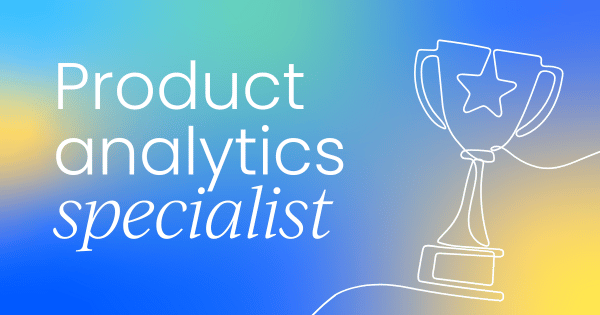You’re swamped. The product backlog is growing, the sprint plan needs a final sign-off, and there’s a new customer segment you need to analyze, pronto.
On top of it all, you’re the go-to person for everything data-related. You're pulling reports, building dashboards, and trying to decipher complex metrics, often while juggling a dozen other responsibilities.
For many product professionals, this scenario is all too familiar. You're a generalist, a jack-of-all-trades expected to master everything from user empathy to data science. But what if you didn't have to do it all alone?
Our latest State of Product Analytics report reveals a significant and fascinating shift in how product organizations are handling data. While product managers have traditionally owned the analytics function, a new model is emerging.
This is the rise of the dedicated product analytics team, and it might just be the competitive advantage your company needs to move faster and build smarter.
The analytics gap: Who’s doing the work?
Here’s a striking finding from our survey: a resounding 66.7% of respondents say product managers are ultimately responsible for product analytics.
This means that for the vast majority of product teams, the PM is the go-to person for everything from data collection to insight generation. This responsibility often falls on PMs as an additional task, not their primary focus.
It's a huge burden. You're expected to be a data wizard, a UX designer, a market strategist, and a master of communication all at once. For most of us, there just aren't enough hours in the day to give each of these areas the attention they deserve.
The result? You're likely spending less time on strategic, high-impact work and more time building reports you should be using, not creating.
This situation isn't just about workload; it's about a lack of specialized expertise. Product management requires a broad skill set, but deep-diving into data – cleaning it, modeling it, and extracting sophisticated insights from it – is a specialist's job.
When PMs are forced to take on this role, the quality and depth of the analysis can suffer, leading to missed opportunities and slower decision-making.
The good news is that organizations are starting to see this problem. While most organizations (a majority of 54.9%) still don't have a dedicated analytics function, the tide is turning.
The prevalence of these specialized functions is rising, and rising fast.
This year, 45.1% of respondents report working with a product analytics team, a massive leap from just 35.5% in 2024. That’s nearly a 10-percentage-point increase in just one year!
This signals that organizations are beginning to understand the value of having specialized, full-time professionals who can go beyond simple dashboards and provide the kind of deep, actionable insights that truly move the business forward.

Why specialists are becoming essential for growth
A dedicated analytics function is becoming a key driver of growth and maturity. Our data shows a strong correlation between a company's stage of development and the presence of a specialized analytics team.
- Among well-established companies and market leaders, 63% have a dedicated analytics function.
- In contrast, only 29.4% of mid-growth companies do.
- For early-stage companies, that number drops to a mere 14.3%.
This gap at the mid-growth stage is particularly telling. These companies are no longer in discovery mode, but they're not yet market leaders. They're trying to scale, monetize, and optimize, but many lack the specialized support to do so efficiently.
They’re caught in a difficult spot: they’re too big to rely on ad-hoc analytics but not yet mature enough to invest in a dedicated team.
This presents a huge missed opportunity. Investing earlier in a dedicated analytics team could help these companies make faster, more informed decisions as they scale and try to leapfrog the competition.
For them, a specialized team could be the difference between getting stuck and truly accelerating.
Parul Jain, Principal Product Manager at Walmart Global Tech, highlights the importance of this specialized function in a large organization: “It’s a capability we continue to evolve by incorporating innovations like GenAI-powered summaries, advanced analytics dashboards, and tools that help us synthesize insights at both global and regional levels...
“In a multimarket environment, this function is essential. It reduces the complexity of working with fragmented regional data, giving product teams a unified view while still enabling local relevance."
For these larger organizations, a dedicated team isn't just about efficiency; it's about centralizing and standardizing data to ensure everyone is working from the same single source of truth.
Without that, you risk falling into what Parul calls the "watermelon status" trap – where everything looks green on the surface, but the underlying data tells a different, more concerning story.
Consistent data sharing, enabled by a centralized team, keeps everyone accountable and focused.

Beyond tracking: The shift to data science
So, what are these dedicated teams focused on? They're moving beyond the basics. Our report found that the most-utilized analytics capabilities are still foundational: tracking at 47% and dashboards at 27.5%. But the future lies in more advanced capabilities.
The sharp rise in planned investment for data science tools is a key indicator of this shift. Jumping from just 3.9% currently invested to a significant 23.5% planning to adopt them next, this shows that product leaders are ready to go deeper.
This isn't just about reporting on past events; it's about leveraging predictive insights. Data science tools allow teams to:
- Predict churn risk before it happens.
- Forecast demand shifts for features or products.
- Uncover operational anomalies that wouldn't be visible in a standard dashboard.
Cindy Camacho, Founder of VOC Strategies, puts it simply: “I think we will continue to see an increase in teams using AI to simplify large volumes of insight to drive action.”
This will be especially critical for busy product teams who need quick access to sentiment analysis for prioritization and roadmapping.
Gaby Paul, Principal/Group Product Manager at Sedex, predicts a future where analytics teams will be “coaching and advising more to avoid becoming bottlenecks as everyone races to launch at pace and learn fast.”
This is a crucial distinction. As more PMs become data-savvy, the role of the analytics specialist shifts from simply providing reports to enabling others to ask the right questions and interpret the data themselves.

A collaborative future for product professionals and data experts
While the responsibility for analytics may be shifting, it doesn't mean the product manager's role is shrinking. Instead, it's evolving.
The rise of dedicated analytics teams allows PMs to move from being data janitors to being strategic partners.
Gaby Paul describes her team's close collaboration with analytics: “The product team works extremely closely with the analytics team to ensure they understand what we're doing, why we're doing it, and what success looks like so we can collectively create the analytics needed to measure success (or failure).”
This collaboration is also reflected in how teams are sharing data. A third of respondents (33.4%) believe everyone in their go-to-market function uses product analytics. Most product teams share data cross-functionally at least once a month (45.1%), with some even sharing insights weekly (21.6%) or daily (9.8%).
By offloading the deep data analysis to specialists, PMs can focus on what they do best: understanding user problems, defining strategy, and shipping great products.
As Cindy Camacho puts it, a dedicated analytics function would "lighten the load and speed up our ability to validate ideas and iterate quickly." The impact is still there, but the time to insight is significantly faster.

What this means for product leaders
The message is clear: the future of product analytics is specialized and collaborative.
While you'll always need a strong foundation in data, the most forward-thinking organizations are investing in dedicated expertise to move from simply tracking to truly predicting and shaping product outcomes.
If you’re a PM, this is your opportunity to advocate for specialized analytics resources. By doing so, you'll not only lighten your own workload but also empower your team to make smarter, faster, and more confident decisions.
If you're currently in a mid-growth company, the data suggests you have a significant opportunity to get ahead of the curve.
The time to build a strong partnership with a dedicated analytics team – or to make the case for creating one – is now.
Our latest report reveals how product managers across industries are leveraging analytics to shape roadmaps, increase retention, and build products users can’t live without.
Want to make faster, better-informed product calls? Get your free copy now 👇



 Follow us on LinkedIn
Follow us on LinkedIn







